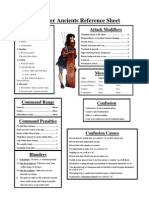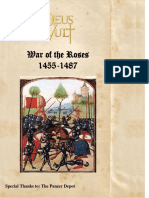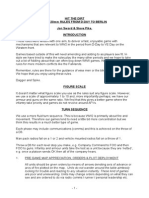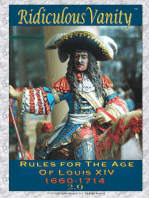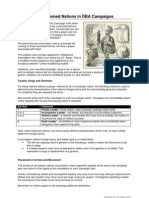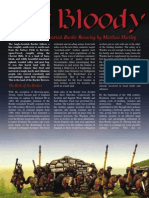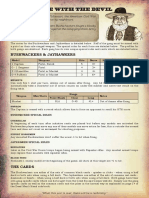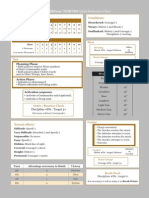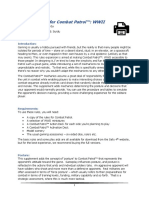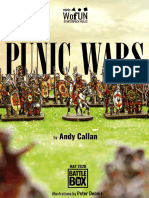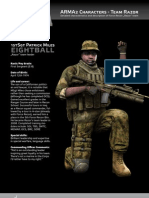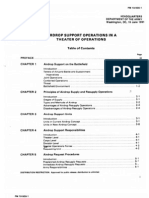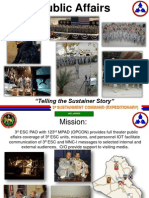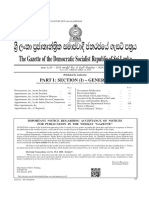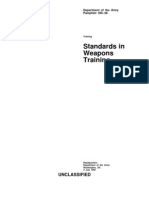Beyond The Pale - Border Reivers Wargaming
Beyond The Pale - Border Reivers Wargaming
Uploaded by
FortriuPictCopyright:
Available Formats
Beyond The Pale - Border Reivers Wargaming
Beyond The Pale - Border Reivers Wargaming
Uploaded by
FortriuPictOriginal Title
Copyright
Available Formats
Share this document
Did you find this document useful?
Is this content inappropriate?
Copyright:
Available Formats
Beyond The Pale - Border Reivers Wargaming
Beyond The Pale - Border Reivers Wargaming
Uploaded by
FortriuPictCopyright:
Available Formats
1
(phone/fax- 01473 630994)
THIS FREE RULE SET can be obtained by either:
email: vendel.patten@virgin.net
Direct download from: www.vendelminiatures.co.uk
FIGURES DESIGNED AND PAINTED BY COLIN AND DUNCAN
PATTEN
mailing: VENDEL MINIATURE 24, BURGESS PLACE, IP5 3QZ.
Tel/Fax: +44 (01473 630994)
R1
Pike
7.00
R2
Pike
7.00
R3
Calivermen Charging
7.00
R4
Calivermen Tunics
7.00
R5
Calivermen Jacks
7.00
R6
Calivermen Breastplate
7.00
R7
Calivermen Tunics Firing
7.00
R8
Calivermen Jacks Firing
7.00
R9A
Calivermen Breastplate Firing
7.00
R9B
Calivermen Jacks Firing
7.00
R10
Calivermen Firing line Load
7.00
R11
Bucklermen Jacks
7.00
R12
Bucklermen Breastplates
7.00
R13
Infantry Command
7.00
R14
Pistolmen
4.00
R15
Crossbow
7.00
R16
Longbow
7.00
RC1
Troopers
8.00
RC2
Troopers
8.00
RC3
Troopers
8.00
RC4
Troopers
8.00
RC5
Troopers
8.00
RC6
Troopers
8.00
RC7
Cavalry Commanders
8.00
GG1 Gallowglass 6 foot figures
6.00
GG2 Gallowglass 4 foot figures
4.00
IR1 The O'Neils 28 foot and 4 Cav
30.00
IR2 Kern Spear 12 foot
12.00
IR3 Kern
Archers
4 foot
4.00
16th
Century
Elizabethan Rules
Original rules written by
Richard Tyson & Graham Harrison
Adapted by Karl Lowthian
2005
INTRODUCTION
These rules are designed to allow you to play one off battles or a loose
campaign/linked series of battles. As with many gamers I started with small riding
families which by themselves grew into almost small armies. Then came the Vendel
Elizabethan miniatures and just to force that wallet open wider; The Irish. The rules
mechanisms will be familiar to those who have played Hot Trod and Red Hand.
Though the principles are the same the differences are that mass battles can be fought
where units are formed. Here is the second difference; instead of a D10, a D20 is
used, this allows for greater variations between weapons and armour.
The army lists are very simple, rather than be highly prescriptive on troop quality and
limiting weapons to the minute detail there are simply lists with basic troop statistics.
This I believe is because regiments, companies of troops and their like were not as
established in the 16th Century so depending upon your belief or reference material,
youre favourite Tercio could be Elite, Superior, average or Poor.
I have placed limited choice upon possible weapons and armour based upon the
historical reference e.g. No fully armours Kerns in the list. Finally I have provided
percentage mixtures between Fire arms, foot and Horse for each of the nations. This
represents my personal view on the troops, however if you wish to increase or
decrease proportions feel free to do so.
The lists started as just Elizabethan English ad the Wild Irish but on reflection and
as I started to research the period more I included the Scots and the Spanish as all
played an important part in the Reign of Elizabeth.
You can expand and develop on these lists so What if armies for the Invasion of the
Armada can be played, Essex expedition to Flanders or The Wars of Religion. I have
also added some generic Mercenary types which was the natural state of the 16th
Century army.
It is suggested that you play a few simple games using only the combat mechanisms
detailed below before using the scenario generation system or a full blown campaign.
And remember, if you dont like a rule or statistic, change it. Wargaming is all about
fun and recreating what feels right for your Tercios.
Historical Background
The service of the English army of the 16th Century was varied, if on a relatively
small scale, continuous trouble and two major conflicts with Scotland, lengthy wars in
Ireland, aid to both sides in the Netherlands and to the Huguenots in France, plus
preparations against various invasions by the Spanish which never came.
The 16th Century brought about the Renaissance of warfare. It was that watershed
period between Medieval armies and the standing armies of later centuries. It saw the
development of massed fire arms and the decline of the Long bow. The period was
also deeply marked as age of the Mercenary and the major Conflicts between nations
and civil war following the reformation.
Bibliography
This lists all books used in the preparation of these rules.
Ian Heath Armies of the 16TH Century 1997
Colm Lennon, Sixteenth Century Ireland The Incomplete Conquest, Dublin 1994.
G. A. Hayes McCoy. Irish Battles 1990.
Nicholas Canny. The Elizabethan Conquest of Ireland, Harvester Press Ltd, Sussex 1976.
George Gush Renaissance Armies 1975
Ian Heath/Osprey The Irish Wars MAA256
John Tincey/Osprey The Armada Campaign Elite 15
GAME BASICS
The game uses twenty sided dice (D20). At any time when a dice is rolled (EXCEPT
when rolling for initiative) a roll of 1 is always a Perfect Success, and a roll of 20 is
always a Total Failure. How this affects various situations will be detailed below.
Figure Statistics
Each class of figure or individual has a line of statistics shown for it, detailing its
abilities during the game. The statistics are as follows:
CC Close Combat skill. The number shown is the base below which the player
needs to roll on a D20 to achieve a hit in melee. A Perfect Success means that the
enemy is killed without being able to make a saving throw. A Total Failure means that
the figure loses any further actions it has available for that turn.
MW Missile Weapon skill. The number shown is the base below which the player
needs to roll on a D20 to achieve a hit when using any kind of ranged weapon. A
Perfect Success means that the enemy is killed without being able to make a saving
throw. A Total Failure means that the figure loses any further actions it has available
for that turn.
LD - Leadership Skill. The number shown is the base below which the player needs
to roll on a D20 to maintain morale, and also for other checks detailed below, for
either the individual figure or group.
A - Actions. The number of actions that each figure can carry out each time it is
activated.
MV - Movement. The distance the figure can move through open terrain per Action
used on foot.
W - Wounds. The number of wounds the figure can take before being removed from
play.
D - Defence. The base from which weapon damage is deducted to see if a wound is
inflicted, this is dependant upon armour
GAME SETUP AND TURN SEQUENCE
1) Set up battlefield. One player should place whatever terrain he wishes. Up to half
the terrain pieces placed may then be moved or removed by the other player.
2) Dice for initiative - roll 1D20 each, the player with the highest score may chose
which side of the table he wishes to deploy on, and the player with the lowest
score then deploys his first group. Deployment is always within 6" of the table
edge unless otherwise specified in scenarios.
3) The players take it in turn to deploy the remainder of their groups, and then battle
commences.
4) Game Turn Sequence:
a) Dice for Initiative as above.
b) The winner may either activate their first unit, or choose a unit of their
opponents to be activated. Units may attempt to Rally, move and/or shoot.
Each player then alternates in activating one unit at a time
c) Melee Phase. All melee combat is simultaneous except for a unit with First
Strike ability.
OTHER ACTIONS AND ATTRIBUTES
UNIT FORMATION
Formed units must have all the figures facing in the same direction.
The only exception is that if a unit is contacted to its flank or rear, then it may use
its next activation to turn those figures in contact to face the enemy.
All units are removed when they are reduced to 3 figures.
REGIMENTS
These were the building Block of armies, whether called regiments, schiltrons,
Tercios or Colbnello.
The unit can contain up to 3 weapon types which cannot exceed over being
firearms.
Usually it would be expected to have melee in the centre with ranged weapons on
either flank. You may arrange differently e.g. Caliver to front then pike with
Billmen supporting to the rear, it is your decision!
IRISH
The Irish regiments can be different when containing Galloglass, up to the unit
may contain these whilst the remainder may contain Kern/Bonnachts.
The Galloglass must always fight in the front rank.
This rule is included to represent the Gallowglass being supported by Horse boys
however you can keep them separate.
SKIRMISHERS
These are loose formed troops which due their open formation can move/face in
any direction.
For the purposes of the rules you can either designate Formed units as skirmishers
or use the skirmisher statistics, Weapons for that type apply.
Missile Skirmishers may move and fire.
Skirmish cavalry may move and fire, those with Javelins and darts may make a
full move and fire without penalty.
INDIVIDUALS
A unit within 4" of a friendly Character may use his LD for tests, providing the
individual is not engaged in melee.
If a friendly individual or army standard is killed all units take a rout test, those in
LOS immediately, and all others the following turn.
If it is the C-in-C, or army standard, test with 2 LD.
Individuals may only be targeted by shooting if they are more than 4" from any
other unit.
Individuals may attach themselves temporarily to a unit and be activated at the
same time as the unit. They will fight in the front rank of the unit in melee.
If the unit suffers shooting casualties there is a proportionate chance of the
individual being hit.
An attached individual may leave the unit at any time.
When an armys last individual is killed, all units take a rout test at 1 LD. If they
fail they flee and are removed.
o If they pass they are determined on revenge and take no further tests for
the rest of the game.
MOVEMENT
Skirmish units may move in any direction.
Formed units can only move forward, or incline up to 45 degrees to either side, or
they may move directly backwards at half speed.
Turns are either made by wheeling from one end of the line, or else by turning all
the figures to face by 90 or 180 degrees.
Turns to face or formation changes (contract/expand frontage) cost half a move.
A unit moves at half speed if in rough ground, fording a river or crossing a linear
obstacle.
Mounted archers/Javelins that shot may still move full speed.
CHARGES
To successfully charge a unit must pass their leadership test.
Charges must be made in a direct line against the nearest unit (chargers may
ignore routing troops).
Chargers who are slowed by terrain do not count charge bonuses.
Ranged Weapon Troops that are contacted may shoot at the chargers if they are in
arc and the firers have not already been activated this turn.
Units contacted to flank or rear may turn to face, but not shoot, provided they
have not yet been activated this turn.
Troops that cannot turn to face do not fight in melee.
BREAKING AWAY.
A unit in contact with an enemy may break off contact during their activation.
The unit breaking off moves a full move away from the enemy and ends the turn
facing away from the enemy.
If the retiring unit moves faster than the enemy in contact, they automatically
succeed in breaking off. Otherwise they must take a Leadership test;
o if they fail the enemy gets a free hack as they break away.
ROUTERS
Routers move at full speed away from enemy and towards their base line.
When a unit routs any enemy it contacts get a "free hack" as the unit breaks away.
Routers must pass a leadership test to rally.
o One a score of 1 they rally instantly and can make a normal activation,
otherwise it takes an entire turn to rally them (even if they are rallied in a
leaders activation).
Unit that roll a 20 for rout or rally tests is immediately removed.
Routers cannot be rallied if an enemy is in base-to-base contact.
LEADERSHIP TESTS
Elite/superior units must take a leadership test when they have lost 1/2 of their
strength
All others after losing 1/3.
Each time the unit suffers an additional casualty it must test.
o If the unit fails it routs.
Leadership tests are subject to the following modifiers;
-2
BELOW 50% STRENGTH
-2
TESTING FOR DEATH OF C-IN-C/ARMY STANDARD
-2
CONTACTED IN FLANK OR REAR
-2
FOOT CHARGED BY CAVALRY THIS TURN (NOT WARGS)
-1
TESTING FOR DEATH OF LAST INDIVIDUAL
+1
WON A MELEE THIS TURN (INFLICTED MORE CASUALTIES
THAN RECEIVED IN MELEE)
+3
ATTEMPTING TO CHARGE FLANK OR REAR
OVERHEAD SHOOTING
Missile troops on higher ground may shoot over intervening friends providing the
target is at least 3 away from the intervening unit.
Units may similarly shoot at a target on higher ground.
MISSILE WEAPON MODIFIERS
SOFT COVER:
HARD COVER (prepared defensive positions):
FIRING OVERHEAD:
SHOOTING WHILST MOVING:
SHOOTING AT A SKIRMISH TARGET:
SHOOTING MOUNTED WHILST MOVING OVER HALF SPEED:
-1 MW.
-2 MW.
-1 MW
-1 MW
-1 MW
-1 MW
MELEE WEAPON MODIFIERS
ATTACKING A DEFENSIVE POSITION
(wall, hedge, ditch, riverbank, uphill etc):
-2CC
10
CHARGE:
CHARGING MOUNTED vs. FOOT:
ATTACKING THE REAR OF A UNIT:
MOUNTED TROOPS IN ROUGH GROUND:
CLOSE FORMATION INF WITH
GREATER DEPTH
+2 CC and +2 DAM.
+2 CC
+2 DAM
-2 CC
+1CC and +1 DAM*
(* to qualify as support rear ranks cannot be more that 2 figures less than the front
rank)
WOUNDS
Most figures are killed when they take 1 wound.
Heroes are killed on 3 wounds.
Other individuals are killed on 2 wounds.
SPECIAL ABILITIES
INDIVIDUALS:
Heroes make three attacks each melee round
All other individuals make two.
MOUNTED:
Cavalry figures may not dismount.
The mount and rider are treated as one figure.
Horse mounted cavalry receive +2CC when charging foot.
Mounted Missile Troops may move full distance and still shoot.
ARQUEBUS:
These can only move or fire
NB. Crossbows are counted as Arquebus for the Rules
DARTS AND JAVELINS:
Count as swords for combat
When charging the first 2 ranks can throw javelins as they enter combat
The First rank may fight hand to hand combat.
PIKE:
When using pikes against non-pike armed units, always count first strike (even if
charged)
Up to 3 ranks can count in combat (this includes any none pike arm troops in front
of the pike e.g. Caliver men)
None pike armed infantry suffer -1 to hit in combat.
DOG HANDLER
Once purchased, the dog handler controls the pack, up to 5 dogs may be bought
per handler and only 2 handlers are permitted per army.
When setting the dogs on the enemy you do not need to roll under initiative.
11
Only once a dog has been lost must you roll under initiative to keep the dogs
attacking, after the first dog has been lost, the initiative suffers -2 penalty for each
dog there after.
Should the handler be killed the pack automatically disperse.
MASTER ARMY STATS
Model
CC
14
General
16
Captain
15
Character
15
Elite
13
Average
Superior
14
12
Skirmishers
10
Levy
12
War Dogs
MW
7
7
7
7
6
7
7
5
0
LD
17
17
16
15
13
14
13
10
As
Handler
W
2
3
2
1
1
1
1
1
1
MV
6
6
6
6
6
6
8
6
9
D
18*
18*
18*
18*
18*
18*
18*
18*
18*
Pts
40
30
25
12
8
10
6
4
15
* This denotes the model has no armour of defence additional armour may be
bought
Class
Armour Type
Defence class 18
Defence class 20
Defence class 22
Defence class 24
Defence Mod +1
Defence Mod +3
No armour
Jack/Akheton and Helmet
Breast plate/Chain mail and helmet
Half armour (Breast, Back plate, Helmet, thigh & arm pieces)
Buckler
Shield
Short Rng Long Rng
Range minus
Weapon
Dagger / Improvised Weapon
Pts
Melee only
0
10
12
16
3
6
Damage
5
Pts
0
12
Sword
Spear
Bill/ Halberd/ Jeddart Axe
Latch (small crossbow)
Pistol
Arquebus / Caliver/ Crossbow
Bow
Pike
Longbow
2-handed sword/ axe
War Spear/Lance
Javelin/Dart
Dog bite
Horse Type
Nag
Hobby
Arab
Melee only
Melee only
Melee only
10"
6"
14"
16"
18"
10"
20"
24"
-3
-4
-5
-3
28
-2
Melee only
20
Melee only
Melee only
9
Melee only
9
11
14
8
10
12
10
12
12
16
12
9
11
2
3
10
2
3
7
6
5
10
12
9
3
N/A
Movement rate
Pts
5" per rider action used
6" per rider action used
7" per rider action used
6
9
12
IRELAND
The Irish indulged in constant raiding and ambushing, frequently of each other, but did not really fight
wars. From 1561 to 1603, however, there were a series of campaigns against the English, culminating
in that of Tyrone.
Warriors of Ireland were very traditional in armament and tactics, but as the wars continued more upto-date weapons made their appearance and some full scale battles were fought, though the traditional
"guerrilla-type" tactics were more successful, as in the Irish victory of the Yellow Ford, 1598. The Irish
made good use of difficult country and of field fortifications, digging trenches and "plashing" trees into
13
impenetrable barriers, often in connection with an ambush.
The Gallowglass
These (originally Scots mercenaries) by the 16th Century their clans or "septs" had often been settled in
Ireland for two or three centuries, they were still mercenaries, but often owed loyalty to a particular
noble .They usually wore an iron bascinet, and either a mail shirt or a short cape of mail over a padded
quilted coat called a "cotun" and their characteristic weapon was a heavy two-handed axe, up to six feet
long, which could chop the enemy's head off with a single blow (it was still used in 1588 when
McLaghlin M'Cabb killed 80 Spaniards from the Armada with one). Gallowglass were organized in
"battles" of 80 or 87 men, but each gallowglass was accompanied by two boys, who carried his
supplies,
armour,
and his secondary weapons, three light Irish javelins or "darts".
The Kern
The ordinary Irish foot soldiers, made up partly of "Bonnachts", or Irish mercenaries maintained by the
various nobles, and partly of free peasantry called out to fight. The Bonnachts might sometimes be
dressed like the gallowglass, or else like the rising-out, as the peasants were called; no armour, simply
the traditional Irish dress of a linen tunic with very wide sleeves, often dyed yellow with saffron,
usually worn over tight trews of a plain colour, and sometimes covered with a very short coat of goat's
hair or a large mantle or "shag-rug", patterned, and with a long fringe .
Bonnachts might have been armed with the sparth-axe, but the usual weapons were javelins or "darts"
of which each kern had a handful; even the English admitted that the Irish were extraordinarily skilled
with this weapon. A few of the kern also used the bow, and a sword or spear and shield might be
carried; the shields were oval and convex, of wood or basket-work. They were often clean-shaven but
wore flowing moustaches and a mop of shaggy hair or "glib" falling over the forehead (banned by the
English as making it difficult to recognize their "thievish countenances"). Their tactics were those of
skirmishers, in difficult country where, often, no other troops could move, but they could also charge
fiercely in the right circumstances, clashing their weapons together with a loud cry of Pharroh.
The Cavalry
A small proportion of the average Irish force, the cavalry would normally be made up of gentry. They
were equipped with a helmet, mail shirt, sword and shield, but their chief weapon was a longish light
spear held in the middle and used over-arm either for stabbing or throwing, not couched as a lance. One
reason for this was that the Irish still used neither stirrups nor a proper saddle; another was that their
light cobs could not stand up to the heavier English horses in a full charge. They were thus mainly
useful for scouting, skirmishing, or pursuit. In the earlier 16th Century the Irish seem to have had the
unusual habit of drawing up the cavalry on the left of their battle line.
Later Changes
14
These started in the 1560s, when Shane O'Neill began to equip his men with arquebus, impress large
numbers of un-free peasants, and hire extra Scots mercenaries from overseas. By 1569 musketeers and
mailed pikemen had appeared in Irish armies.
The "New Scots"
These were a new wave of Scots mercenaries, mainly recruited from the Western Isles. They were
probably bare-legged (hence their nickname of "Redshanks") and generally dressed like other
Highlanders of the period. Organized in companies with strength of 100, they included firearms,
pikemen, and halberdiers, as well as men with the more traditional Highland weapons, longbows and
two-handed claymores. They were found in most Irish armies in the second half of the 16th Century,
though they had most of the usual faults of mercenaries and came quite expensive.
Tyrone's
Army
Hugh O'Neil, Earl of Tyrone, created the first really effective Irish army of the period, using as a
nucleus Irish infantry he had kindly offered to train for Queen Elizabeth, and senior officers who had
served in the English or Spanish armies. He raised 6,000 disciplined Irish foot, organized in companies
of 100 and regiments probably 500 strong, with drums, bagpipes and colours, and armed with
matchlock muskets and there were at least two musketeers to every pikemen, probably more. On the
flanks of his "regular" forces, numbers of skirmishers with the older types of weapon operated, and
there were also "New Scots", including Tyrone's own bodyguard of 200 musketeers. Tyrone normally
used harassing tactics in difficult country, but at the disastrous battle of Kinsale his forces drew up in
the open in three large Tercio-style blocks.
RESTRICTIONS
MOUNTED TROOPS
FIRE ARMS
MERCENARIES
The ONeil
Chieftain
Galloglass
Noble
Bonnachts
Kerns
Horse Boys
Red Shanks
General
Captain
X
X
X
X
Character
up to 20% of army total
up to 20% of army total
up to 20% of army total
THE IRISH
Elite
Average
Superior
Skirmisher
Levy
X
X
X
X
Horse
X
X
X
X
X
X
X
X
X
X
X
X
15
Jack/Akheton
and Helmet
Breast/Chain
mail plate
helmet
Half armour
Buckler
The
ONeil
X
Chieftain
Galloglass
X
X
X
X
X
X
Noble
Bonnachts
X
X
Spear
Bill/Halberd/
Jeddart Axe
Latch (small
crossbow)
Pistol
Horse
Boys
Red
Shanks
X
X
X
X
X
X
X
X
X
X
X
X
X
X
X
X
X
X
X
X
X
X
X
X
X
X
X
X
Shield
Dagger /
Improvised
Weapon
Sword
Kerns
Arquebus
Caliver
Bow
Pike
Longbow
2-handed
sword/ axe
War
Spear/Lance
Javelin/Dart
X
X
X
Nag
Hobby
Arab
X
X
X
X
ENGLAND
In the early 16th Century, nearly all were the traditional Billmen and longbow men, both usually equipped with a jack
and with a simple rounded helmet of sallet type. Even by the 1550s this was still largely true, corselets and morions
being rare, and multi-layered canvas jackets or even mail shirts being still favoured. Among 28,000 English foot taken
to France in 1544, there were less than 2,000 arquebus, and Billmen outnumbered pikemen three or four to one.
Henry had to hire Spanish and Italian arquebus, and German pikemen.
The older weapons were gradually supplanted by the new, and in 1558 English companies in Ireland had about 50
each of longbow and arquebus. However, in the mid-1580s the general muster of the counties still included 32
percent archers, as against 40 percent with firearms and 28 percent corselets, or pikemen. Such counties as
Wiltshire, Derby, Oxford and Bucks were the main suppliers of archers.
English infantry companies varied from 100 to 400 in strength, 150 standard in the 1590s. The word "Regiment" had
a very vague meaning in the mid-16th Centuryall the troops operating in the Netherlands, 6,000 or more, forming
one "regiment"but by the later part of Elizabeth's reign, regiments were fairly definite organizations, commanded by
a colonel. They could be of ten companies, as later, but in Ireland were often of five.
"Men-at-Arms", with heavy lance, full armour, and often barded horse, were still used in the first half of the century,
but were few in number. Much more numerous were the "Demilances", with corselet only or three-quarter armour,
open burgonet, and unbarded horse. These men carried a lighter lance, and later pistols, and formed the main
English heavy cavalry up to the end of the century. In the late 16th Century, Demilances formed a fifth of the English
cavalry, the rest being light horse.
The characteristic English light cavalry were those variously referred to as "Javelins", "Prickers", "Northern spears" or
"Border Horse". They also were armed with lance and one pistol, sometimes carrying a round or oval shield as well,
and wore an open helmet, mail shirt or jack (corselet for the wealthier individuals), leather breeches, and boots. Such
cavalry were supplied by several English counties, but the best came from the raiders of the Scottish border, who
were reputed to spear salmon from the saddle!
16
By 1586 the Government were also trying to raise "Petronels"unarmoured cavalry with firearms. Cavalry were
always in short supply in English armies; Henry VIII supplemented them with Burgundians, and Germans with boar
spear and pistols. In Ireland in the later 16th Century, cavalry usually formed about one-eighth of an English army. In
Henry's time they were organized in bands, cornets, or squadrons of 100 men, later of about 50.
In the early 16th Century, white was a favourite colour for English troops (the Tudor colours were green and white); in
the later part of the century red became most widely used. Blue, however, was also widely worn, and, for Irish
service, cassocks (loose long or short coats, sometimes hooded or sleeveless, and worn over equipment) were
usually to be of russet, green.
Cavalry in Elizabeth's reign seem to have favoured red, tawny or orange colours; Border horse usually wore white,
and could wear "blue bonnets" like the Scots. English archers, too, often wore "Scots caps" in red or blue, over their
helmets, and cavalry helmets were likewise sometimes covered with red or parti-coloured caps.
The sign of the English soldier, worn on breast and back in the first half of the 16th Century, and found on shields
and pennons later, was the red cross of St. George. Toward the end of the century sashes, worn about the waist or
over the right shoulder by officers, and some pikemen and cavalry, became the usual national distinction. Red, or red
and white, seems to have been worn by the English.
Officers were distinguished from their men, just as in other armies of this period, by armament (sword and buckler,
half-pike, or partisan being favourite officers' weapons), and by rich clothing with silk and lace, gold or silver trim,
decorated armour, and jewellery.
RESTRICTIONS
MOUNTED FIRE ARMSMERCENARIESGeneral
Essex/
Mountjoy
Colonel
Captain
Soldiers
Pale Militia
Border
Horse
Demi
Lancers
Petronel
Dog
Handler
Captain
UP TO 25% OF ARMY
UP TO 50% OF ARMY
UP TO 15% OF ARMY
THE ENGLISH
Character
Elite
Average
Superior
Colonel
Horse
X
X
X
Mountjoy
Levy
Essex/
Skirmisher
X
X
Captain
Soldier
Pale
Militia
Border
Horse
Demi
Lance
Petronel
Dog
Handler
17
Jack/Akheton
and Helmet
Breast/Chain
mail plate
helmet
Half armour
Buckler
Shield
Dagger /
Improvised
Weapon
Sword
X
X
Bill/Halberd
X
X
Arquebus
Caliver
Bow
Pike
Longbow
2-handed
sword/ axe
War
Spear/Lance
Javelin/Dart
Spear
Latch (small
crossbow)
Pistol
X
X
X
X
X
X
Hobby
Arab
Nag
X
X
SPAIN
Spain was the dominant military power of 16th Century Europe, her troops were the only real, that is, in the sense
that they alone were permanently employed. Spanish commitments were as great as Spanish wealth, and her troops
fought in Spain itself, Oran and Tripoli, Italy, Ireland, France, Central and South America, and above all, in the Low
Countries, which were under Spanish control from 1519.
The Tercios
Emerging in the early 1530's, these were a new step in infantry organization, for the Spanish or any other European
armythe first large permanent infantry units with territorial titles and enduring traditions and esprit de corpsthey
soon acquired nick-names, such as "The lnvincibles" and "The Immortals". they were the ancestors of all later
regiments.
They were created by amalgamating existing Corunelas. This gave an organization of 12 companies of 258 men
each, two being of Arquebusiers only, the others of both Arquebusiers and pikemen, giving a roughly 50:50 ratio of
pikes to shot (rather advanced for its time).This set-up seems to have lasted through the 16th Century, with only two
significant changes. The first was a decrease in the proportion of pikemen, which fell to 40 percent by the 1580's; the
second, the introduction of the musket. This weapon was pioneered by the Spanish army, and seems to have
appeared in the Tercios in the 1560's. Parma's army in the Netherlands is said to have had more musketeers than
Arquebusiers.
A Tercio was commanded by a Maestre de Campo, assisted by a "Sargente Mayor" there may well have been a few
halberdiers and sword-and-buckler men included among the Tercio pikemen as well, but they would not have formed
over about five or ten percent of the pikes.
The infantry wore close fitting hose from the waist down, often with calf-high Moorish boots of red Morocco leather; a
tunic with a very wide and long skirt might also be worn. Even Arquebusiers could wear a plate corselet, but mail
shirt, studded brigantine, or plain leather jerkin was a more usual type of protection. Nearly all seem to have had
helmets, simple sallets, burgonets, or cabasset morions. Red was a popular colour, and scarlet military cloaks are
mentioned.
As in later years, the Spanish infantry were supplemented by mercenariesmainly Italian skirmishers with
Arquebusiers, and Germans with pike or arquebus.
In the mid to late 16th Century short stuffed breeches were worn, doublets could also be padded; coats with hanging
sleeves were often worn. Spanish were particularly characterized by the stiff white neck-ruff. The national
distinguishing mark was, first, the Red Cross (X), on back and breast, later, the red sash worn by officers, pikes and
18
cavalry.
After the early 16th Century, only pikemen, halberdiers, sword-and-buckler men and officers were likely to wear plate
armoura corselet, often with gorget and armour for the shoulders, arms and thighs (at least half the Spanish
pikemen were armoured). Armour could be blackened. 16th Century Arquebusiers often wore mail shirts or leather
jerkins for protection.
The Cavalry
The standard of their mounts and armour is said to have been below that of other nations, and in the later 16th
Century they did not usually form more than about ten percent of the usual cavalry force..
Lancers
The lighter cavalry found in other armies (English Demi-lances, for example) they were particularly characteristic of
the Spanish. They wore three-quarter armour, open helmets, and rode un-armoured horses.
Ginetes
They were typical Spanish light cavalry of the early 16th Century. Dashing skirmishers, they carried the heart-shaped
Moorish leather-covered shield, and used Moorish tacticsfeigned retreats and so on. Their chief weapons were
sword and javelin. Some had plate armour, but most had mail shirt or brigantine, steel cap or morion, and odd bits of
arm or leg armour.
Stradiots and Italians
Stradiots were first hired by the Spanish in 1507, and later considerable numbers of Italian light cavalry were also
hired, and usually armed with the arquebus.
Firearm Cavalry
Firearm cavalry or escopeteros appeared early in the Spanish army. The two chief types of the 16th Century were
the Herreruelos and the Herguletiers (mounted Arquebusiers).
The Herreruelos were armed with pistols and fairly heavily armoured, corresponding to the hired German Reiters
and other cuirassier types, while the Arquebusiers were lighter, only about half of them wearing corselets, the rest
leather. Both could play a similar role, operating on the front or flanks of men-at-arms or lancers, the Herreruelos
would be more likely to charge in themselves. Both types carried swords, and Arquebusiers sometimes carried a
pistol as well as the arquebus.
The Spanish did not consider Germans very highly, but their horse was cheap and plentiful, and often formed from 25
to 40 percent of the Spanish cavalry. Indeed, one should remember that a large part of any Spanish army was
usually non-Spanishin 1588 the Duke of Parma's army of 60,000 men had only 18 percent Spaniards, whereas
Germans and Walloons, in their own units, made up about a third of the army each! 12 percent were Italian, other
nationalities the remaining five percent. It is usually said, that cavalry were a small proportion of Spanish armies.
Certainly the infantry were the chief strength, but later the cavalry seem usually to have formed from a quarter to a
third of the army.
RESTRICTIONS
MOUNTED
FIRE ARMS
MERCENARIES -
UP TO 20% OF ARMY
UP TO 50% OF ARMY
UP TO 33% OF ARMY
SPANISH
General
Elite
Average
Superior
Lancer
Herreruelos
Maestre de
Campo
Coronels
Captain
Character
Levy
Horse
Sargente
Mayor
Soldier
Stradiots
Ginetes
Chaplain
Jack/Akheton
and Helmet
Skirmisher
Maestre
de Campo
Coronels
Sargente
Mayor
Soldier
Lancers
Herreruelos
Stradiots
X
Ginetes
X
Chaplain
19
Breast/Chain
mail plate
helmet
Half armour
Buckler
Shield
X
X
Dagger /
Improvised
Weapon
Sword
Spear
Bill/Halberd/
Jeddart Axe
Latch (small
crossbow)
Pistol
Arquebus
Caliver
Bow
Pike
Longbow
2-handed
sword/ axe
War
Spear/Lance
Javelin/Dart
X
X
Nag
Hobby
Arab
X
X
SCOTLAND
Scots provided a steady flow of mercenaries to richer nations, serving with distinction, most notably in French, Dutch
and Swedish armies, where they provided both complete regiments. In the 16th Century there was a continuous
conflict of raid, counter-raid and minor battle on the Border, punctuated by the great clashes of Flodden (1514) and
Pinkie (1547), both Scots defeats, plus internal conflict in the later part of the century, involving the expulsion of
French forces with English aid.
The Lowland Pikemen
The spear was the traditional weapon of the Scots, suited to a poor land with little cash or metal to spare and
dependent on an armed peasantry for defence; the solid blocks of spearmen or "schiltrons", which met the English on
many a medieval battlefield, had a long history behind them, back possibly to the ancient Picts, who had also formed
tight clumps of spearmen in battle.
Scots forces were based on a militia system not unlike that of England, Scots being obliged to equip themselves for
war according to rank, and gentry to maintain feudal contingents, appearing for the Sheriff's inspection at biannual
"Wappinshaws". The weapons listed as acceptable at Wappinshaws of the 16th Century included spears and pikes,
longbows, crossbows, two-handed swords, halberds, Leith axes and Jeddart Staves (the latter two were long, broadbladed two-handed axes, similar to a halberd without its spike). Hand guns were also to be provided, and by 1535
20
landed men were ordered to equip themselves with an arquebus-a-croc, but at Pinkie the Scots had few firearms,
lack of missile power was a major weakness in their 16th Century armies.
Mid-century Scots pikemen mostly wore a simple iron helmet, a jack, and white doublet and hose, the sleeves and
thighs of the latter being guarded against sword-cuts by four or five rows of brass chain. A large kerchief was wound
three or four times round the neck, "Not for cold, but for cutting", and further protection was provided by a round
buckler held in the left hand, even when grasping the pike; secondary weapons were broadsword and dagger.
Lowlanders of the 16th Century commonly wore the "blue bonnet", and other usual clothing colours were grey and
light blue. Pikemen formed 70 percent or more of Scottish armies at the larger battles of the period.
The Highlanders
All Highlanders were warriors, following their chiefs to battle, and in the 16th Century still roused by the sending
round of the "fiery cross" summoning them to the traditional mustering-place. They were found in all Scottish armies
of the period; usually 15 percent of the larger ones.
Their arms were, firstly, the bow: Secondly the claymore, which throughout our period was a two-handed sword. A
dirk and a flat round "targe", usually leather-covered and decorated with embossing and metal nails and boss,
sometimes spiked, would also be carried.
In the 16th Century the Highlanders, if not equipped with a helmet, would be bareheaded. 16th Century Highland
dress consisted of the "leine croich", a linen knee-length shirt, usually dyed yellow with saffron, and worn with a
voluminous mantle or plaid secured with a brooch. Short coats and trews could also be worn, the latter being in the
16th Century sometimes knee-length.
The only protection commonly worn by 16th Century Highlanders was a tar-stiffened leine covered with deerskin, but
in any case they often stripped for battle, though sometimes retaining the shirt, the sides of which were tucked into
the belt, the resultant "tails" at front and rear being tied between the legs. Up to the 16th Century, a chief might wear
a padded quilted coat called a "cotun".
Plaids, often trews, and sometimes jackets were chequered, striped or parti-coloured, frequently in early tartan
patterns which were simple and with a large "set". As yet they did not identify clans, and a simple black and red style
seems to have been popular. Other colours favoured were purple, blue and brown.
Highlanders were ferocious but unreliable, relying either on skirmishing or a single volley followed by a wild charge;
they hated, and would not stand up to, cannon, which they called "the mother of muskets".
The Cavalry
Cavalry was a very small component of most Scots armies. Scots suffered by being lightly-mounted on small,
"scrubby nags" better suited to Border skirmishes than a stand-up fight. Wappinshaws suggest that the ordinary
gentry would wear corselet, jack or brigantine, bascinet helmet, gorget, "splints" for arms and upper legs, and mail
hand and knee protection. Great nobles could have full plate armour. Basic weapon would be the lance but at both
the great 16th Century battles the King and nobles dismounted and fought in the front rank of the pike columns.
Usually the chief mounted troops of Scots armies were "Border Horse" armed with light lance, sword, and, by 1600,
one pistol, with "steel bonnet"often covered by a capand corselet, mail or jack as protection; leather breeches
and boots. They were distinguishable, if at all, from their English counterparts only by chequered plaids and the
saltire of St. Andrew on breast and back.
RESTRICTIONS
MOUNTED
FIRE ARMS
MERCENARIES
UP TO 15% OF ARMY
UP TO 33% OF ARMY
UP TO 10% OF ARMY
SCOTS
General
Scots Laird
Colonel
Captain
Highlanders
X
X
Captain
Character
X
X
X
X
Elite
Average
Superior
Skirmisher
Levy
Horse
21
Soldiers
Border Horse
Wappinshaw
Jack/Akheton
and Helmet
Breast/Chain
mail plate
helmet
Half armour
Buckler
X
X
X
X
X
X
X
X
Scots
Laird
Colonel
Captain
Highlander
Soldier
Border
Horse
Wappinshaw
X
X
X
X
X
X
Shield
Dagger /
Improvised
Weapon
Sword
Spear
Bill/Halberd/
Jeddart Axe
Latch (small
crossbow)
Pistol
Arquebus
Caliver
Bow
X
X
Pike
Longbow
2-handed
sword/ axe
War
Spear/Lance
Javelin/Dart
X
X
X
X
Nag
Hobby
Arab
MERCENARIES
These have been added for the sake of history. Not every troop type or nationality has
been added. Remember English, Scots, Irish and Spanish also fought as mercenaries
so if you wish to add these to your armies e.g. Irish Chieftains in the service of the
English please do so.
The Condottiere is listed as a Character he is the archetypal mercenary
Officer/Individual
MERCENARIES
General
Condottiere
Captain
Character
Elite
Average
Superior
Skirmisher
Levy
Horse
22
Italian Stradiot
X
X
Italian
Arquebus
German Pike
German Ritter
X
Condottiere
Jack/Akheton
and Helmet
Breast/Chain
mail plate
helmet
Half armour
Italian
Stradiot
Italian
Arquebus
German
Pike
German
Ritter
X
X
Buckler
X
X
X
X
Shield
Dagger /
Improvised
Weapon
Sword
Spear
Bill/Halberd/
Jeddart Axe
Latch (small
crossbow)
Pistol
Arquebus
Caliver
Bow
Pike
Longbow
2-handed
sword/ axe
War
Spear/Lance
Javelin/Dart
Nag
Hobby
Arab
THE CAMPAIGN
These rules rally represent linked scenarios and to the relief of most requires no map.
The theatre of war can be anywhere. Some Ideas for your campaign;
Essex or Mountjoy on Campaign in Ireland
Parma in Holland or the Invasion of England with the Armada
The Earl Of Leicester on campaign in Flanders
AP This represents the resources of your armies in the form of Money, Food stuff
and materials. Each Player will start with a specified Treasury (Nominally 2000 AP)
before purchasing your Army NB you can raise or lower this treasury and army AP
limits to suit your own forces.
23
The Treasury can be increased by successful battles and by Autumn when
taxes/harvest are collected each year.
Each Campaign year will consist of 4 seasons. 3 fighting seasons and Winter when
reinforcements may be recruited and forces re-organised. During the winter players
may spend their treasury to rebuild their army to a maximum of 1500AP (again this
can be increased or decreased depending upon your model collection)
CAMPAIGN SEASON
Each Fighting season players write down their status, either defending or Attacking an
enemy (or ally!) faction. At this point it adds flavour to name where your Army is
Based e.g. Kinsale or a province/county state.
If a player attacks an undefended region he is automatically successful, unless
the defending player call out the militia on which a defended battle is fought
If a player attacks a defended region then fight a defended battle
If two players attack each other, or two players attack the same defended
region then fight an encounter battle
After the Battle
A player regains all routed troops
Dice for each casualty;
o If the player Drew the battle, the casualty is regained on a score of
10 or less (D20)
o If the player Won the battle, the casualty is regained on a score of
12 or less (D20)
o If the player Lost the battle, the casualty is regained on a score of 8
or less (D20)
Militia
A player can call out the militia (local levy Wappinshaw, Rising out or camp
followers) for one season in each year if attacked whilst the Army is not at
Base camp.
Militia do not have any AP cost and any loses are automatically regained for
the following year.
If the Militia are called out at Harvest Time (Autumn season) the owning
players Harvest will be decreased.
Militia consist of;
o 3 Regiments of 20 figures, lowest grade troops (no more than 8 may
have firearms or missile weapons)
o 1 unit of 10 skirmishers again at lowest grade troops
24
o Dice at the start of the game for each unit, on a score of 7 or less the
unit comprises veterans or men who are seasoned in combat treat as
regulars. Otherwise the units are of the lowest class e.g. Poor
End of Campaign Year
Each successful attack earns 200 in loot for the attackers and the defender
loses 50 in income.
If the militia is called out during the autumn (harvest time) the player loses
100 in income that year.
These figures are added or subtracted from the points remaining in your live
army plus Money remaining in your Treasury
BATTLES
Defended Battle
Attacker rolls 1D20
Unless otherwise stated, defender lays out terrain including an objective
(village/bridge/crossroads etc) and Attacker chooses his base edge
All units set up within 12 of their base edge
1-2
3-4
5-16
17-18
19-20
Ambushed; No objective on table. Defender lays terrain and nominates
Attackers base edge. Attacker sets up at least 18 from table edge.
Defender sets up anywhere on table, but no closer than 9 to any enemy
troops. Defender automatically starts with initiative. Any Attackers units
that route off the table edge except their own count as lost.
Waiting for You; Place objective on Defenders table edge. Only 75% of
Attackers troops arrive. Defender sets up last and may place two units on
Ambush anywhere on table, at least 9 away from Attackers troops.
Place objective on Defenders table edge. Deploy normally
Surprise; Place objective on Defenders table edge. Only 75% of Defenders
troops are present, reinforcements arrive after 4 turns
Complete Surprise; Place objective on Defenders table edge. Only 75% of
Defenders troops are present, no reinforcements
Encounter Battle;
Both roll D20
25
Highest score lays out terrain and lowest chooses base edge
All units set up within 12 of their base edge
Both roll on encounter table
1-2
3-4
5
6-18
19-20
Confused; only 50% of army starts on table, 25% reinforcements arrive
after turn 4.
Confused; only 75% of army starts on table, 25% reinforcements arrive
after turn 4.
Find stray herd of cattle which must be escorted home by 10 mounted
figures (use foot if no mounted) Gain 100AP but the escort do not arrive
for the battle
Full strength, deploy normally
Surprise; Full strength, one unit may be placed last anywhere on the table
at least 9 from opponents troops.
You might also like
- I Ain't Been Shot Mum - in The - Richard ClarkeDocument17 pagesI Ain't Been Shot Mum - in The - Richard ClarkeJoseSilvaLeite100% (2)
- WMA Ref SheetDocument2 pagesWMA Ref Sheetdonpeppe1100% (1)
- Give Them The Cold Steel RulesDocument30 pagesGive Them The Cold Steel Rulesseth_crockettNo ratings yet
- En Garde!: Swashbuckling Skirmish Wargames RulesFrom EverandEn Garde!: Swashbuckling Skirmish Wargames RulesRating: 4.5 out of 5 stars4.5/5 (2)
- The Pikeman’s Lament: Pike and Shot Wargaming RulesFrom EverandThe Pikeman’s Lament: Pike and Shot Wargaming RulesRating: 4.5 out of 5 stars4.5/5 (3)
- For King or Empress WVDocument43 pagesFor King or Empress WVbrixio8baracus100% (1)
- Deus Vult - War of The Roses PDFDocument8 pagesDeus Vult - War of The Roses PDFGiovanni100% (1)
- Basic Impetvs Quick Reference Sheet Movement InitiativeDocument1 pageBasic Impetvs Quick Reference Sheet Movement Initiativeduguqiubai100% (1)
- Hit The Dirt 20mm Wwii Rules From D-Day To Berlin - ModifiedDocument15 pagesHit The Dirt 20mm Wwii Rules From D-Day To Berlin - ModifiedPete GillNo ratings yet
- 158th Field Artillery Official Extract No. 171Document332 pages158th Field Artillery Official Extract No. 171John JensonNo ratings yet
- Hot TrodDocument28 pagesHot TrodSpanishfuryNo ratings yet
- Colonial Skirmish RulesDocument10 pagesColonial Skirmish RulesBeagle75100% (1)
- Muskets and Springfields: Wargaming the American Civil War 1861-1865From EverandMuskets and Springfields: Wargaming the American Civil War 1861-1865No ratings yet
- Ridiculous Vanity : Rules for the Age of Louis XIV 1660 - 1714 2.0From EverandRidiculous Vanity : Rules for the Age of Louis XIV 1660 - 1714 2.0No ratings yet
- Enhanced Rampant: by Richard CowenDocument8 pagesEnhanced Rampant: by Richard CowenAdam BrzostekNo ratings yet
- To The Strongest Army Lists - Kingdoms of The EastDocument55 pagesTo The Strongest Army Lists - Kingdoms of The EastMiguel Angel Martinez Fernandez100% (1)
- Colonial Wargames Rules Based On Pony WarsDocument3 pagesColonial Wargames Rules Based On Pony WarsRob Heath50% (4)
- Father Tilly - TYW RulesDocument39 pagesFather Tilly - TYW Rulesbrixio8baracusNo ratings yet
- List of Barons For Barons WarDocument14 pagesList of Barons For Barons Warmark.chisholm75No ratings yet
- Border Reiver War RulesDocument11 pagesBorder Reiver War RulesSpanishfuryNo ratings yet
- Osprey - Chosen Men - Russia List - CM2Document5 pagesOsprey - Chosen Men - Russia List - CM2John100% (1)
- RCW CoC Markers LetterDocument5 pagesRCW CoC Markers Letteroso291970100% (2)
- Lion Rampant Reference SheetDocument2 pagesLion Rampant Reference Sheetchris100% (5)
- Le Roi Soleil DeluxeDocument10 pagesLe Roi Soleil DeluxeUberSpoonsNo ratings yet
- Bolt Action WW1Document51 pagesBolt Action WW1Jd DibrellNo ratings yet
- IronsidesDocument26 pagesIronsidesJoshua Reyes100% (1)
- BBB - KWC Napoleonic AmendmentsDocument2 pagesBBB - KWC Napoleonic AmendmentsHenk VervaekeNo ratings yet
- DBA Programmed NationsDocument5 pagesDBA Programmed NationsDon Mc100% (2)
- Daimyo Rules 10Document23 pagesDaimyo Rules 10Christopher DobsNo ratings yet
- Bloody Borders Part OneDocument7 pagesBloody Borders Part OneSlorm54100% (1)
- BFE II ScenariosDocument25 pagesBFE II Scenarioselmitxel100% (1)
- Dux Bellorum MedievalDocument5 pagesDux Bellorum MedievalEndakil100% (2)
- FOGN v2 FastplayDocument10 pagesFOGN v2 FastplayJosé S Aguilar SNo ratings yet
- Trial by Fire - RulebookDocument87 pagesTrial by Fire - RulebookSpyros Georgios Pachos100% (1)
- Ride With The DevilDocument4 pagesRide With The Devil2shedsrobinsonNo ratings yet
- Pz8 Rules Collection v3Document24 pagesPz8 Rules Collection v3Mark GossNo ratings yet
- 2 by 2 Napoleonic's 2LrvhDocument11 pages2 by 2 Napoleonic's 2LrvhjohnNo ratings yet
- Mud & BloodDocument68 pagesMud & BloodUngrad100% (5)
- Contemptible Little Armies 3E PDFDocument130 pagesContemptible Little Armies 3E PDFI.M. Awesomeman100% (1)
- Lions LammentDocument5 pagesLions LammentPeterBrown100% (1)
- Setting The East Ablaze! V6.3.4Document34 pagesSetting The East Ablaze! V6.3.4Brett Michael Chinchen50% (2)
- Maurice LiteDocument23 pagesMaurice LitePeter Douglas100% (4)
- Nottingham - Middle Age SkirmishDocument52 pagesNottingham - Middle Age SkirmishAdam Tilinger100% (3)
- Raid On DabulamanziDocument19 pagesRaid On Dabulamanzijp100% (1)
- Drums & Muskets French & Indian War Skirmish RulesDocument64 pagesDrums & Muskets French & Indian War Skirmish Rulesccm2361No ratings yet
- Quick Reference ChartDocument1 pageQuick Reference ChartKraken Las Palmas100% (1)
- English Civil War DBA Campaign (V Nov08)Document1 pageEnglish Civil War DBA Campaign (V Nov08)Bruno Friedrich KriegspielNo ratings yet
- The Battle of DreuxDocument7 pagesThe Battle of DreuxfiorenzorNo ratings yet
- Combat Patrol Solo Rules Printer FriendlyDocument11 pagesCombat Patrol Solo Rules Printer FriendlyAntony WhyteNo ratings yet
- Hordes in The Trenches Version 2Document10 pagesHordes in The Trenches Version 2John Donovan0% (1)
- Warhammer Ancient Battles Chariot Wars Updated 30 Oct 2012Document51 pagesWarhammer Ancient Battles Chariot Wars Updated 30 Oct 2012RiccardoCiliberti100% (1)
- WoR PDF Scenarios 1464 1487Document46 pagesWoR PDF Scenarios 1464 1487David Philip100% (5)
- 321 Fast Play Napoleonic Rules v4.4Document6 pages321 Fast Play Napoleonic Rules v4.4Tzergo CorolaNo ratings yet
- Colonial Skirmish RulesDocument10 pagesColonial Skirmish RulesA Jeff ButlerNo ratings yet
- Valour Fortitude Version 1.2Document8 pagesValour Fortitude Version 1.2re-pete100% (2)
- Warning Order 03 - WO3RDDocument14 pagesWarning Order 03 - WO3RDDistractionManNo ratings yet
- Andy Callan Punic Wars StarterPack RulesDocument11 pagesAndy Callan Punic Wars StarterPack RulesAndrew Smith100% (1)
- Small Unit Tactics For Light WeaponsDocument137 pagesSmall Unit Tactics For Light WeaponsAdam_Guthrie_9348No ratings yet
- Covering Fire!: General Principles Playing The Game MeleeDocument1 pageCovering Fire!: General Principles Playing The Game MeleedraksNo ratings yet
- An Introduction To Psychological WarfareDocument11 pagesAn Introduction To Psychological Warfareriggeraty100% (1)
- ARMA2 RazorTeam GC2008Document5 pagesARMA2 RazorTeam GC2008m9aceNo ratings yet
- Meeting The Challenge.: 1-4 - Army Field Manual I Warfighting Tactics - Part 1 The FundamentalsDocument1 pageMeeting The Challenge.: 1-4 - Army Field Manual I Warfighting Tactics - Part 1 The FundamentalsGrozny GroznyNo ratings yet
- March 3 Letter From Ukraine Mission To U.N.Document4 pagesMarch 3 Letter From Ukraine Mission To U.N.Robert MackeyNo ratings yet
- The Army's Stryker Vehicle - A Costly Mistake RASSERDocument50 pagesThe Army's Stryker Vehicle - A Costly Mistake RASSERmr268100% (1)
- 5 War Ford 98Document4 pages5 War Ford 98Denny Prijadi100% (1)
- 019AWI Action - Logistics AshoreDocument74 pages019AWI Action - Logistics Ashorejosephlandgraf100% (1)
- Marne Blue Book Version 3 1 Jun 2022Document52 pagesMarne Blue Book Version 3 1 Jun 2022jorliza123No ratings yet
- A History of The Women Marines 1946-1977Document264 pagesA History of The Women Marines 1946-1977Bob Andrepont100% (1)
- FM - 10 500 1Document4 pagesFM - 10 500 1Meito Datau0% (1)
- FM 34-36 Special Operations Forces Intelligence and Electronic Warfare Operations (SEP 1991)Document200 pagesFM 34-36 Special Operations Forces Intelligence and Electronic Warfare Operations (SEP 1991)Empireball100% (1)
- Srebrenicareportniod en Part03Document582 pagesSrebrenicareportniod en Part03Francisco Fernando ArchiduqueNo ratings yet
- Battlefleet Gothic Tactics TorpedoDocument3 pagesBattlefleet Gothic Tactics Torpedoairfix1999100% (1)
- Air Force Doctrine Publication (Afdp) 3-03 Counterland OperationsDocument4 pagesAir Force Doctrine Publication (Afdp) 3-03 Counterland OperationsChris Whitehead100% (1)
- German Motorised Infantry CompanyDocument2 pagesGerman Motorised Infantry Companypanhard_somua100% (1)
- T-90 TankDocument4 pagesT-90 TankNguyễn Thế Hùng0% (1)
- Stanag A231Document54 pagesStanag A231Ahmet ÖztemürNo ratings yet
- Arquus ScarabeeDocument2 pagesArquus Scarabeebastien.postel100% (1)
- Aircraft Counter Hijacking TrainingDocument2 pagesAircraft Counter Hijacking TrainingBryan Joshua VillarNo ratings yet
- Calculating 'Mech BV: Step 1: Calculate Defensive Battle RatingDocument23 pagesCalculating 'Mech BV: Step 1: Calculate Defensive Battle RatingManlio CipulloNo ratings yet
- Presentation To Defense Information School On Leveraging Hometown EngagementDocument26 pagesPresentation To Defense Information School On Leveraging Hometown EngagementPaul R. HayesNo ratings yet
- Ys%, XLD M Dka S%L Iudcjd Ckrcfha .Eiü M %H: The Gazette of The Democratic Socialist Republic of Sri LankaDocument50 pagesYs%, XLD M Dka S%L Iudcjd Ckrcfha .Eiü M %H: The Gazette of The Democratic Socialist Republic of Sri LankaSanaka LogesNo ratings yet
- Weapons Training p350 38Document180 pagesWeapons Training p350 38Ed GonzalesNo ratings yet
- Battle of KulmDocument8 pagesBattle of KulmjhawkesNo ratings yet
- USN and USNSCC Terms and SlangDocument70 pagesUSN and USNSCC Terms and SlangShaun Johnson100% (2)
- Ukraine SubmunitionsDocument6 pagesUkraine SubmunitionsJose LuisNo ratings yet

